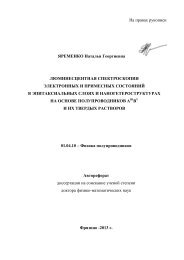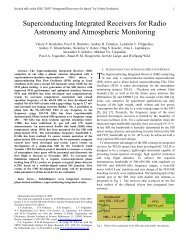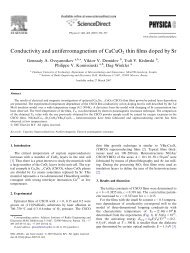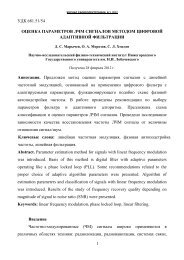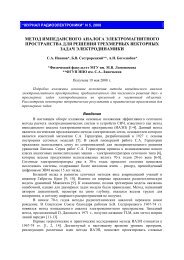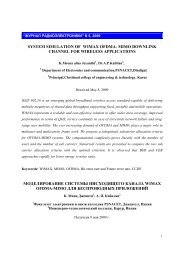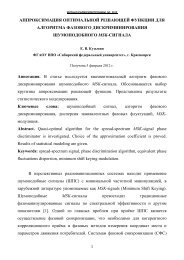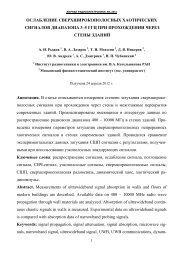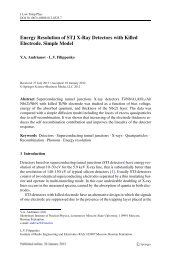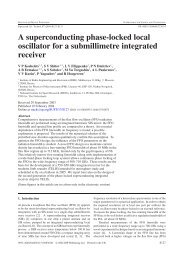Quench-induced trapping of magnetic flux in annular Josephson ...
Quench-induced trapping of magnetic flux in annular Josephson ...
Quench-induced trapping of magnetic flux in annular Josephson ...
You also want an ePaper? Increase the reach of your titles
YUMPU automatically turns print PDFs into web optimized ePapers that Google loves.
In theory, the creation <strong>of</strong> a <strong>flux</strong>on with direction <strong>in</strong> through the oxide towards the center<br />
<strong>of</strong> the annulus, and the creation <strong>of</strong> one with opposite direction should be equally probable.<br />
However, because <strong>of</strong> the detection mechanism <strong>in</strong>herent to this setup, there is no obvious way<br />
to discrim<strong>in</strong>ate between the two states. Us<strong>in</strong>g the current detection scheme (see section 3.3)<br />
results <strong>in</strong> the same outcome regardsless <strong>of</strong> the directionality <strong>of</strong> the <strong>flux</strong>on.<br />
3. Measurements<br />
The actual experimental procedure consists <strong>of</strong> a large number <strong>of</strong> heat<strong>in</strong>g-cool<strong>in</strong>g-measurement<br />
cycles for different cool<strong>in</strong>g rates. For each cycle, the sample is electrically heated, passively<br />
cooled without electrical connections and f<strong>in</strong>ally the actual detection takes place.<br />
3.1. Thermal control<br />
The thermal part <strong>of</strong> the cycle is performed by electrical heat<strong>in</strong>g by resistive strips <strong>in</strong> either end<br />
<strong>of</strong> the sample, as seen <strong>in</strong> figure 2. In order to avoid electro<strong>magnetic</strong> noise <strong><strong>in</strong>duced</strong> by current<br />
noise <strong>in</strong> the heaters, the heat<strong>in</strong>g pulse is mechanically switched <strong>of</strong>f outside <strong>of</strong> the cryoprobe<br />
dur<strong>in</strong>g cool<strong>in</strong>g and measurements. Cool<strong>in</strong>g takes place passively through the helium exchange<br />
gas (approximately 7-8 mbar <strong>of</strong> pressure) as well as through the copper sample holder. The<br />
cool<strong>in</strong>g rate can be controlled by the exchange gas pressure and the heat<strong>in</strong>g time. For longer<br />
heat<strong>in</strong>g times, more <strong>of</strong> the copper sample holder is heated along with the silicon sample. This<br />
gives a larger effective heat capacity <strong>of</strong> the total system, and thus a slower cool down.<br />
Figure 2. Layout <strong>of</strong> one <strong>of</strong> the samples used <strong>in</strong> measurements. For this geometry, the four<br />
junctions are numbered 1 through 4 from left to right. The dimensions <strong>of</strong> the whole sample<br />
is 3mm by 4.2mm. The meander l<strong>in</strong>es seen at either end <strong>of</strong> the sample are resistors used for<br />
heat<strong>in</strong>g.<br />
For slow quenches, a solid-state germanium resistor mounted <strong>in</strong> the copper sample holder<br />
is used to determ<strong>in</strong>e τ Q . However, for faster quenches, <strong>in</strong> which τ Q is less than a few seconds,<br />
thermal equilibrium is not obta<strong>in</strong>ed between the sample and the sample holder. For this, a much<br />
faster thermometer is required. This is supplied by the device itself, as the <strong>Josephson</strong> junction<br />
can be used as a transition edge thermometer <strong>in</strong> constant-current bias mode. The junction is<br />
biased at 25-30% <strong>of</strong> the maximum gap current, and the voltage response as a function <strong>of</strong> time<br />
is measured, see fig. 3(a). This can be directly converted <strong>in</strong>to a temperature as long as T < T C<br />
for the junction [10]. As τ Q is decided by the time-derivative <strong>of</strong> the temperature <strong>of</strong> the device<br />
at T = T C an extrapolation is performed to this us<strong>in</strong>g a simple thermal relaxation model. In<br />
general, the fit to the thermal model is excellent (correllation coefficient, R 2 > 0.98) as is seen<br />
<strong>in</strong> fig. 3(b).



